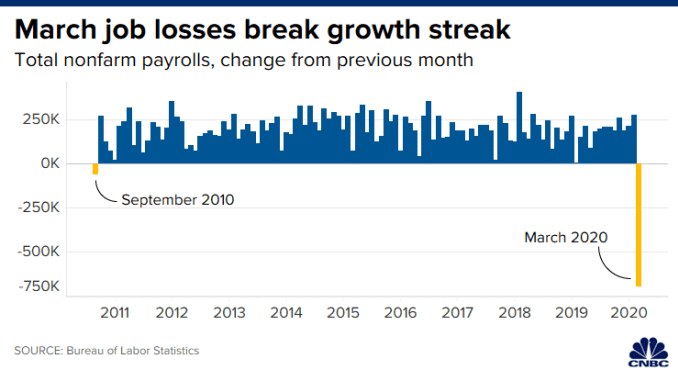Stocks fell on Friday to end another volatile week of trading, pressured by a spike in coronavirus-related deaths in New York while investors digested a dismal U.S. jobs report.
The Dow Jones Industrial Average slid 360.91 points, or 1.7%, to 21,052.53. The S&P 500 dropped 1.5% to 2,488.65. The Nasdaq Composite also pulled back 1.5% to close at 7,373.08.
Wall Street posted its third weekly decline in four. The Dow lost 2.7% this week while the S&P 500 fell 2.1%. The Nasdaq ended the week down 1.7%.
New York Gov. Andrew Cuomo said deaths in the state rose by 562 in 24 hours to more than 2,900 for the biggest increase to date. Cuomo added the curve of confirmed cases “continues to go up,” noting there are now over 100,000 cases in New York state.

“This still feels like something we’re heading into, not heading out of,” said Brian Nick, chief investment strategist at Nuveen. “We can see the light behind us, but not ahead of us.”
“The upside scenario is disappearing very quickly and the base case is getting worse,” said Nick.
There have been more than 261,000 confirmed infections in the United States and more than 6,600 deaths from COVID-19, according to data from Johns Hopkins University. Globally, more than 1 million cases have been confirmed.
Massive job losses in the US
U.S. payrolls fell by 701,000 in March, marking the worst jobs report since 2009, while the unemployment rate jumped to 4.4%. However, the report failed to capture the full extent of the ongoing economic blow from the coronavirus outbreak. On Thursday, the Labor Department said jobless claims jumped by a record of 6.6 million for the week of March 27.

“Today’s nonfarm payrolls data confirms what we’ve already known: the U.S. economy was doing well before COVID-19′s impact was felt, and COVID-19′s impact has been severe,” said Lauren Goodwin, multi-asset portfolio strategist at New York Life Investments. “Job losses will continue to surge as the national shutdown strengthens its hold on the U.S. economy.”
American Express, UnitedHealth and IBM fell more than 3% each to lead the Dow lower. Some of those losses were offset by Walmart, which turned around to close 0.7% higher after a report said the company’s sales have jumped 20% in the past month. Utilities and financials led the S&P 500 lower, falling 3.6% and 2.3%, respectively.
Stocks got a slight boost earlier in the day as oil rose 12%, adding to its biggest one-day rally on record. West Texas Intermediate futures soared 24% on Thursday for their best day ever, lifting the major stock indexes. The Dow and S&P 500 gained more than 2% on Thursday.
“Trends have now been sideways for US and European equities for the last seven trading sessions, despite the massive swings,” said Mark Newton, managing member at Newton Advisors, in a note. “Gains have consolidated, but have not given way to much weakness that is sufficient to expect an immediate test of low.”
Both the Dow and S&P 500 remain more than 26% below their respective all-time highs set in February as jitters over the spread of COVID-19 foster volatile trading on Wall Street.